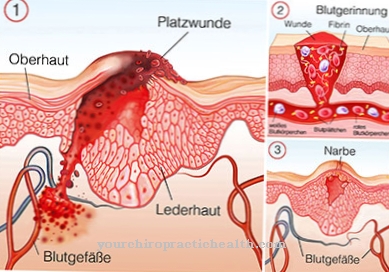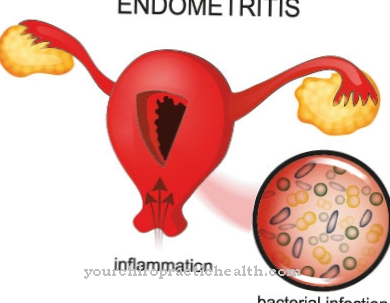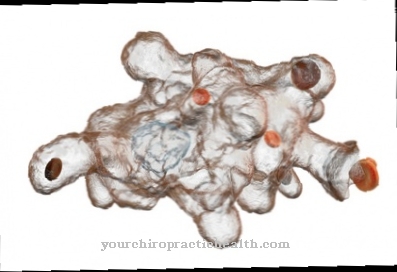Lacerations are among the usual injuries that occur in the course of a person's life and usually heal easily and without complications. In the case of large lacerations or those that bleed very heavily and permanently, medical advice should be sought to ensure good wound care. This also ensures optimal wound healing of the laceration.
What is a laceration?

© Henrie - stock.adobe.com
Lacerations are - usually heavily - bleeding injuries to the skin. These occur particularly often on parts of the body where the skin lies very close to the bone.
Lacerations can often be found on the head, elbow or shin, i.e. wherever there is little or no cushioning layer of fat. The wound edges of a laceration are usually well supplied with blood, but depending on the type of laceration, they can also be severely torn or soiled.
causes
A Laceration occurs when a person's skin hits a hard or blunt object and thus bursts. This is also known as blunt force exposure.
Children and adolescents very often get lacerations through learning new movements or sporting activities and the associated falls. But even older people who can no longer walk and stand safely are at risk of lacerations if they fall.
The cause of a fall in older people can also be a stroke, which is why a laceration must be clarified in this case.
Symptoms, ailments & signs
A laceration is usually caused by strong external force. The most obvious symptom of a laceration is profuse bleeding. Even small lacerations often develop a large flow of blood that needs to be stopped immediately. In contrast, severe pain is not a typical symptom of a laceration.
However, due to the high blood loss, it can lead to considerable dizziness. Under certain circumstances, the blood loss can be so great that it even leads to a fainting attack. Particularly strong violence can even damage the underlying bone. If there is a fracture, it is of course associated with considerable pain.
In many cases, medical treatment and medication are necessary, as otherwise a deep laceration cannot grow together properly. Sensory disturbances are also a common symptom associated with a laceration. This can lead to permanent numbness.
A strong and long-lasting tingling sensation is also possible, so that this is also a clear sign of an existing laceration. In general, lacerations should always be treated by a doctor so that a smooth recovery can be guaranteed. Otherwise, you face ugly scars that will last for years.
Diagnosis & course
A Laceration can usually be diagnosed relatively clearly without medical help. In order to assess the extent and depth of the laceration, it is nevertheless advisable to ask a doctor for advice. Medical advice should be sought, especially in the case of heavily bleeding or very extensive lacerations, as are particularly common on the skull.
The doctor will first ask how the laceration was caused and then clarify how bad the injury is. After the initiation of a suitable treatment, the chances of recovery are very good - provided the laceration does not become infected with germs. In some cases, after healing, a scar appears in the area of the injury, which is especially the case with large or deep lacerations.
Complications
Lacerations particularly affect children who injure themselves while playing or cycling. But adults also occasionally get lacerations. In healthy people, these injuries usually heal without complications. In any case, the wound should be cleaned thoroughly and then covered with a plaster or bandage, otherwise it could become infected.
Caution is advised if dirt or soil has got into the wound and there is no tetanus vaccination. People who have not been vaccinated against tetanus should always watch out for relevant symptoms. Anyone who suffers from pain and muscle stiffness in the head area or from swallowing disorders after an injury with an open wound must see a doctor immediately. Tetanus is life-threatening and must be treated as early as possible.
People who suffer from haemophilia run the risk of bleeding to death even with otherwise harmless injuries and should therefore consult a doctor as a precautionary measure in the event of lacerations.
Complications can also occur in people with severely weakened immune systems. There is a risk here that germs that penetrate through the open wound will not be eliminated by the body, but will multiply and get into the organs. In these cases there is a risk of blood poisoning (sepsis).
When should you go to the doctor?
A laceration is usually caused by strong external force, such as a fall. It often occurs in the head area and is associated with profuse bleeding. A visit to the doctor is essential if there is an existing laceration, as otherwise various complications can arise. An appropriate doctor can quickly stop the heavy bleeding and ensure that the wound is properly closed. Bacteria and germs cannot get into the wound, so that a dangerous infection can be avoided.
If the person concerned does not receive medical and drug care, the risk of infection is very high. Bacteria can cause an infection within a short period of time, causing the formation of pus fluid. A doctor should be consulted immediately at the first sign of such an infection. Otherwise there is a risk of blood poisoning. The following applies: A laceration can be treated quickly and effectively with medical treatment and medication. Without proper treatment, dangerous complications can arise.
Treatment & Therapy
At a Laceration, which is accompanied by heavy bleeding, the bleeding should first be stopped, which can be done with the help of a pressure bandage, for example. In order not to introduce germs into the laceration, it is strongly recommended to use sterile bandages such as compresses.
If the wound is bleeding profusely or if the edges of the laceration are very wide apart, a doctor or hospital visit is required. There the laceration is medically examined and disinfected. In the case of very deep or large lacerations, it may be necessary for the doctor to clasp or sew them in order to support optimal wound healing and avoid scarring.
At the same time, the doctor will examine whether further injuries such as broken bones have occurred in the area of the laceration. The treating doctor also checks the important protection against tetanus and, if necessary, refreshes it.
For smaller, less bleeding lacerations, you do not necessarily need to see a doctor. However, the laceration should be disinfected to avoid infection of the open area. If the laceration was caused by a fall on the head, a visit to the doctor or hospital is absolutely advisable in order to rule out a concussion as a result of the fall. Adequate care of the laceration is also guaranteed there.
prevention
One Laceration It is very difficult to prevent, as almost everyone suffers one or more lacerations in the course of their life. The use of a helmet and well-fitting joint protectors helps to protect sensitive parts of the body, especially during sporting activities. The use of walking aids such as a rollator is recommended for older people to make them more safe when walking. In this way an attempt can at least be made to prevent a laceration.
Aftercare
The aftercare measures are based on the treatment of the wound. If the laceration has been sewn, the threads of the wound must be pulled after a few days. The doctor will inform the patient whether the pulling of the sutures needs to be done at home or in the office. Then the scar must be cared for. The laceration can be protected from contamination with a plaster for one to two weeks.
Then, depending on the position of the laceration, a fatty cream or a gentle scar gel with active ingredients such as dimethicone or dexpanthenol can be applied. A care product from the drugstore or pharmacy is particularly recommended for redness, itching and a feeling of tension. At the same time, the scarring can be reduced by careful massages. If the healing process is positive, the wound should quickly and completely close and the scar should fade.
The doctor will need to double-check the injury to rule out any inflammation or adhesions. Follow-up care is provided by your family doctor or a dermatologist. In the case of major injuries, a clinic may have to be visited to pull the stitches and medically treat the scar. A healed laceration that does not cause any discomfort does not require any further follow-up examination.
You can do that yourself
A laceration does not necessarily have to be treated by a doctor. Smaller, above all not deep lacerations, can also be treated in self-treatment. Self-help is also possible with medically treated lacerations, which can contribute to faster healing of the injured area.
If a laceration is treated yourself, the wound must first be cleaned of dirt and disinfected in order to avoid infection later. The wound is then covered in a sterile manner, either with a plaster or a bandage over a compress. In the event of bleeding, the dressing solution must be renewed in good time or pressure must be applied to the wound before bandaging until the bleeding has stopped. Elevating the affected extremity helps stop the bleeding. If you want to be on the safe side, let the doctor check the wound again for infection or scarring.
Self-help is also possible with a wound that has been treated by the doctor and perhaps even stapled and sewn. This includes dressing changes recommended by the doctor as well as the omission of all measures that can disrupt the healing process. This includes watertight shielding of the wound when showering or bathing as well as consistent protection against contamination. In the case of lacerations near the eyes, it is better to refrain from wearing make-up and applying pressure through glasses until the wound is closed and healed.

.jpg)


.jpg)









.jpg)













